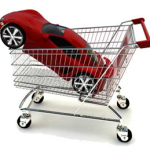 The Federal Reserve announced today that consumer credit has risen by $13.8 billion. This was the biggest rise in consumer spending in three months. The growth was mostly due to higher auto sales, with lenders continuing relatively easy lending in the auto market and car dealers are quickly and aggressively courting the U.S. consumer.
The Federal Reserve announced today that consumer credit has risen by $13.8 billion. This was the biggest rise in consumer spending in three months. The growth was mostly due to higher auto sales, with lenders continuing relatively easy lending in the auto market and car dealers are quickly and aggressively courting the U.S. consumer.
Despite this headline, stocks are down, and the very small-cap car industry ETF (CARZ) is down over 1.2% on double average volumes. The DJI, Nasdaq, and S&P 500 (SPY) indices are all down too, with Bloomberg and other financial journalists pointing the finger at lingering economic concerns and global pressures.
Yet the headline about consumer borrowing is a very good indicator of an improving U.S. economy, coming as it does on the back of several other strong indicators, such as falling unemployment rates and a rebounded Fed Reserve focus on employment. That’s not to mention the repatriation of factory work, growing global demand for U.S. products, and stagnant oil and natural gas prices thanks in no small part to greater domestic energy production.
All of these accumulate to a healthy economic recovery in America, but the key is whether consumers believe that America is back enough to open up their wallets. In the kind of economy that America is, this is really the key to sustaining growth: because your spending is my income and vice versa and because America is a consumer-driven economy, any indication that consumers are less scared of losing their savings is a sign that the American economy can bounce back from the horror of 2008.
The car industry, in early 2013, decided that Americans had had enough saving and were ready to spend. The average age of cars on America’s roads was reaching an all-time high and car sales were so low that many analysts were considering whether Millennials, due to lack of interest and lack of funds, were simply abandoning America’s car-centric culture. Car makers struck back.
They were fighting several headwinds; unemployment is still at unacceptable levels and Millennials are more likely to dislike cars than other generations. They want to ride a bike and get some exercise, or they want to surf the internet on their phone on a train. The stigma of public transport is gone, and young people are less likely to have a driver’s license than ever in American history. On top of that, many drivers are looking for fuel economy and are awaiting improvements of the electric car before replacing their current vehicle.
A lot of resistance, but that didn’t stop an aggressive push that, ultimately, bore a lot of fruit; most of the major car manufacturers started posting strong revenue growth and/or higher expectations for the rest of 2013 and 2014. The cycle has turned to car makers’ favor.
The fact that Americans have gone back to buying cars despite cultural and technological shifts away from the car, and the fact that Americans are taking on more debt to fund these purchases, suggests that the U.S. economy is indeed in recover mode, or at least consumers see it this way. And with that indicator, great consumer confidence is likely on the way, and with it, greater revenue for everyone. Thus today’s bear market may be short lived in the long run. The big question is how long that long run will be.
